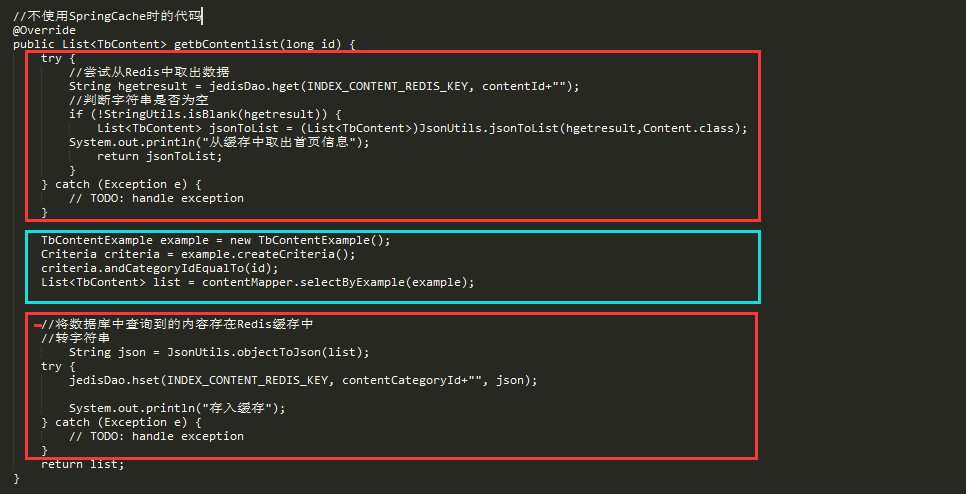SpringCache與redis集成,優雅的緩存解決方案
緩存可以說是加速服務響應速度的一種非常有效並且簡單的方式。在緩存領域,有很多知名的框架,如EhCache 、Guava、HazelCast等。Redis作為key-value型數據庫,由於他的這一特性,Redis也成為一種流行的數據緩存工具。
在傳統方式下對於緩存的處理代碼是非常臃腫的。
例如:我們要把一個查詢函數加入緩存功能,大致需要三步。
一、在函數執行前,我們需要先檢查緩存中是否存在數據,如果存在則返回緩存數據
二、如果不存在,就需要在數據庫的數據查詢出來。
三、最後把數據存放在緩存中,當下次調用此函數時,就可以直接使用緩存數據,減輕了數據庫壓力。
那麽實現上面的三步需要多少代碼呢?下面是一個示例:

上圖中的紅色部分都是模板代碼,真正與這個函數有關的代碼卻只占了1/5,對於所有需要實現緩存功能的函數,都需要加上臃腫的模板代碼。可謂是一種極不優雅的解決方案。
那麽如何讓臃腫的代碼重回清新的當初呢?
AOP不就是專門解決這種模板式代碼的最佳方案嗎,幸運的是我們不需要再自己實現切面了,SpringCache已經為我們提供好了切面,我們只需要進行簡單的配置,就可以重回當初了,像下面這樣:

只需要加一個註解就可以了,對於原來的代碼連改都不需要改,是不是已經躍躍欲試了?
對於配置SpringCache只需要三步:
第一步:加入相關依賴:
<dependency> <groupId>redis.clients</groupId> <artifactId>jedis</artifactId> <version>2.9.0</version> </dependency> <dependency> <groupId>org.springframework.data</groupId> <artifactId>spring-data-redis</artifactId> <version>1.6.0.RELEASE</version> </dependency> <dependency> <groupId>org.apache.commons</groupId> <artifactId>commons-lang3</artifactId>
<version>3.3.2</version> </dependency>
第二步:配置SpringCache,Redis連接等信息
applicationContext-redis.xml
<?xml version="1.0" encoding="UTF-8"?> <beans xmlns="http://www.springframework.org/schema/beans" xmlns:xsi="http://www.w3.org/2001/XMLSchema-instance" xmlns:p="http://www.springframework.org/schema/p" xmlns:context="http://www.springframework.org/schema/context" xmlns:mvc="http://www.springframework.org/schema/mvc" xmlns:cache="http://www.springframework.org/schema/cache" xsi:schemaLocation="http://www.springframework.org/schema/beans http://www.springframework.org/schema/beans/spring-beans-4.2.xsd http://www.springframework.org/schema/context http://www.springframework.org/schema/context/spring-context-4.2.xsd http://www.springframework.org/schema/mvc http://www.springframework.org/schema/mvc/spring-mvc-4.2.xsd http://www.springframework.org/schema/cache http://www.springframework.org/schema/cache/spring-cache-4.2.xsd">
<!-- 配置文件加載 -->
<context:property-placeholder location="classpath:*.properties"/>
<cache:annotation-driven cache-manager="cacheManager"/> <!-- redis連接池 --> <bean id="poolConfig" class="redis.clients.jedis.JedisPoolConfig"> <property name="maxIdle" value="${redis.maxIdle}" /> <property name="maxWaitMillis" value="${redis.maxWait}" /> <property name="testOnBorrow" value="${redis.testOnBorrow}" /> </bean> <!-- 連接工廠 --> <bean id="JedisConnectionFactory" class="org.springframework.data.redis.connection.jedis.JedisConnectionFactory" p:host-name="${redis.host}" p:port="${redis.port}" p:password="${redis.pass}" p:pool-config-ref="poolConfig"/> <!-- redis模板 --> <bean id="redisTemplate" class="org.springframework.data.redis.core.RedisTemplate"> <property name="connectionFactory" ref="JedisConnectionFactory" /> </bean> <bean id="cacheManager" class="org.springframework.cache.support.SimpleCacheManager"> <property name="caches"> <set> <!-- 這裏可以配置多個redis --> <bean class="com.cky.rest.utils.RedisCache"> <property name="redisTemplate" ref="redisTemplate" /> <property name="name" value="content"/> <!-- name對應的名稱要在類或方法的註解中使用 --> </bean> </set> </property> </bean> </beans>
redis.properties文件:
# Redis settings
# server IP
redis.host=192.168.100.55
# server port
redis.port=6379
# server pass
redis.pass=
# use dbIndex
redis.database=0
#max idel instance of jedis
redis.maxIdle=300
#if wait too long ,throw JedisConnectionException
redis.maxWait=3000
#if true,it will validate before borrow jedis instance,what you get instance is all usefull
redis.testOnBorrow=true
第三步,編寫Cache接口實現類
Spring對於緩存只是提供了抽象的接口,並且通過接口來調用功能,沒有具體的實現類,所以需要我們自己實現具體的操作。
在上面配置中可知,每個實現類都會註入一個redisTemplate實例,我們就可以通過redisTemplate來操作redis

package com.cky.rest.utils; import java.io.Serializable; import org.apache.commons.lang3.SerializationUtils; import org.springframework.cache.Cache; import org.springframework.cache.support.SimpleValueWrapper; import org.springframework.dao.DataAccessException; import org.springframework.data.redis.connection.RedisConnection; import org.springframework.data.redis.core.RedisCallback; import org.springframework.data.redis.core.RedisTemplate; public class RedisCache implements Cache { private RedisTemplate<String, Object> redisTemplate; private String name; @Override public void clear() { System.out.println("-------緩存清理------"); redisTemplate.execute(new RedisCallback<String>() { @Override public String doInRedis(RedisConnection connection) throws DataAccessException { connection.flushDb(); return "ok"; } }); } @Override public void evict(Object key) { System.out.println("-------緩存刪除------"); final String keyf=key.toString(); redisTemplate.execute(new RedisCallback<Long>() { @Override public Long doInRedis(RedisConnection connection) throws DataAccessException { return connection.del(keyf.getBytes()); } }); } @Override public ValueWrapper get(Object key) { System.out.println("------緩存獲取-------"+key.toString()); final String keyf = key.toString(); Object object = null; object = redisTemplate.execute(new RedisCallback<Object>() { @Override public Object doInRedis(RedisConnection connection) throws DataAccessException { byte[] key = keyf.getBytes(); byte[] value = connection.get(key); if (value == null) { System.out.println("------緩存不存在-------"); return null; } return SerializationUtils.deserialize(value); } }); ValueWrapper obj=(object != null ? new SimpleValueWrapper(object) : null); System.out.println("------獲取到內容-------"+obj); return obj; } @Override public void put(Object key, Object value) { System.out.println("-------加入緩存------"); System.out.println("key----:"+key); System.out.println("key----:"+value); final String keyString = key.toString(); final Object valuef = value; final long liveTime = 86400; redisTemplate.execute(new RedisCallback<Long>() { @Override public Long doInRedis(RedisConnection connection) throws DataAccessException { byte[] keyb = keyString.getBytes(); byte[] valueb = SerializationUtils.serialize((Serializable) valuef); connection.set(keyb, valueb); if (liveTime > 0) { connection.expire(keyb, liveTime); } return 1L; } }); } @Override public <T> T get(Object arg0, Class<T> arg1) { // TODO Auto-generated method stub return null; } @Override public String getName() { return this.name; } @Override public Object getNativeCache() { return this.redisTemplate; } @Override public ValueWrapper putIfAbsent(Object arg0, Object arg1) { // TODO Auto-generated method stub return null; } public RedisTemplate<String, Object> getRedisTemplate() { return redisTemplate; } public void setRedisTemplate(RedisTemplate<String, Object> redisTemplate) { this.redisTemplate = redisTemplate; } public void setName(String name) { this.name = name; } }View Code
在配置過程中曾經出現過兩次錯誤:
1.Xxxx.ClassNotFoundException 最後發現是jar下載不完整,把maven本地倉庫的對應jar包文件夾刪除完從新下載就好了
2.Xxxx.MethodNotFoundException 這種情況是版本不對,換成第一步中的版本就可以了
SpringCache中常見註解的使用:
@Cacheable註解
最常用的註解,會把被註解方法的返回值緩存。工作原理是:首先在緩存中查找,如果沒有執行方法並緩存結果,然後返回數據。此註解的緩存名必須指定,和cacheManager中的caches中的某一個Cache的name值相對應。可以使用value或cacheNames指定。
如果沒有指定key屬性,spring會使用默認的主鍵生成器產生主鍵。也可以自定義主鍵,在key中可以使用SpEL表達式。如下:
@Cacheable(cacheNames=”content”,key=”#user.userId”) Public User getUser(User user){ xxxxx }
可以使用condition屬性,來給緩存添加條件,如下:
@Cacheable(cacheNames=”content”,key=”#user.userId”,condition=”#user.age<40”) Public User getUser(User user){xxxxx}
@CachePut註解
先執行方法,然後將返回值放回緩存。可以用作緩存的更新。
@CacheEvict註解
該註解負責從緩存中顯式移除數據,通常緩存數據都有有效期,當過期時數據也會被移除。
此註解多了兩個屬性:
allEntries是否移除所有緩存條目。
beforeInvocation:在方法調用前還是調用後完成移除操作。true/false
SpringCache與redis集成,優雅的緩存解決方案

